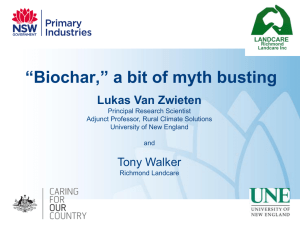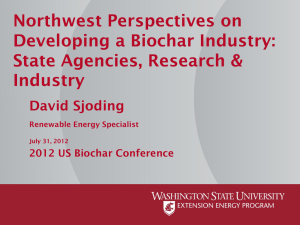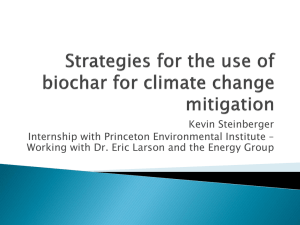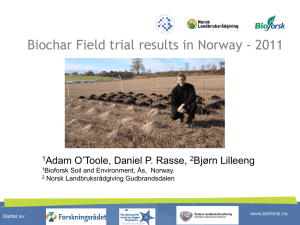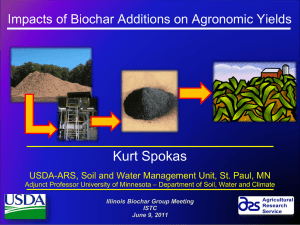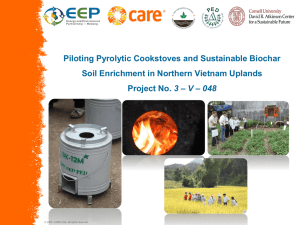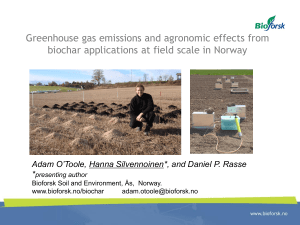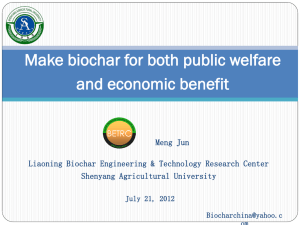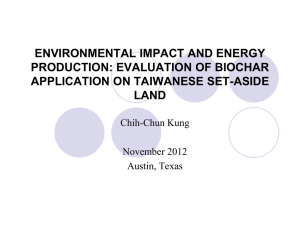biochar
advertisement
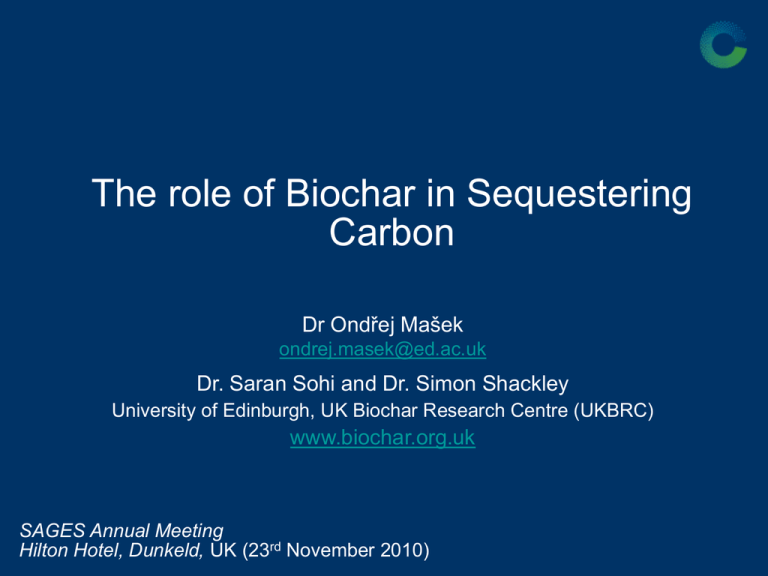
The role of Biochar in Sequestering Carbon Dr Ondřej Mašek ondrej.masek@ed.ac.uk Dr. Saran Sohi and Dr. Simon Shackley University of Edinburgh, UK Biochar Research Centre (UKBRC) www.biochar.org.uk SAGES Annual Meeting Hilton Hotel, Dunkeld, UK (23rd November 2010) Talk outline • What is biochar and the Biochar Pyrolysis System (PBS) • Value of biochar in climate change mitigation • Key issues in biochar deployment • Biochar potential in Scotland • Introduction to the UK Biochar Research Centre (UKBRC) Ondřej Mašek, Dunkeld, 23rd November, 2010 SAGES Annual Meeting Drivers for biochar Ondřej Mašek, Dunkeld, 23rd November, 2010 SAGES Annual Meeting What is biochar? Char made of biomass and for use in soil 20 mm Photo: Shackley & Cook, UKBRC may include and outwardly resemble charcoal but can be quite different (functionally) in soil 0.2 mm Ondřej Mašek, Dunkeld, 23rd November, 2010 SAGES Annual Meeting Biochar – can give a complex and perhaps confusing picture Ondřej Mašek, Dunkeld, 23rd November, 2010 SAGES Annual Meeting The pyrolysis-biochar system (PBS) ? CO2 photosynthesis 6 Gt y-1 biomass C (energy) 60 Gt y-1 soil C ? pyrolysis biochar C fossil carbon fossil C Ondřej Mašek, Dunkeld, 23rd November, 2010 SAGES Annual Meeting Biochar production - Carbon rich product of biomass pyrolysis - Can take many forms and have different properties Traditional charcoal burning air smoke char Batch pyrolysis kiln char oil, tar, liquids Industrial unit for continuous production char gas, oil, tar Ondřej Mašek, Dunkeld, 23rd November, 2010 SAGES Annual Meeting Value of biochar in climate change mitigation “Carbon equivalents” over defined timeframe: 1. Permanent C storage (direct avoided CO2 emission) – 2. stabilisation of C from degradable organic matter Production of renewable energy – 3. direct CO2 offset (depends on current and future energy mix) Suppression of N2O – 4. indirect emission avoided (unpredictable but accruing) Net increase in soil organic matter – 5. indirect carbon storage (unpredictable and reversible) Impacts on agricultural resource and land-use – – reduced requirement for energy (fertiliser, irrigation, machinery) relative reduction in rate of land-use change Ondřej Mašek, Dunkeld, 23rd November, 2010 SAGES Annual Meeting 1.Permanent C storage - Biochar stability • Key factor in determining the GHG reduction potential of biochar. • Not yet well understood. • Tools for rapid assessment of stability of different biochars are needed. • Stability in the order of centuries to millenia is needed, this appears to be the case for most biochars, however scientific verification is needed. UKBRC accelerated aging tool Ondřej Mašek, Dunkeld, 23rd November, 2010 SAGES Annual Meeting Biochar stability The yield of stable carbon is critical! yield [wt.% feedstock (db.)] 35 stable ash free char 30 25 20 expected 15 10 5 stable ash free char 0 300 350 400 450 500 550 600 temperature [C] Results from the accelerated aging analysis clearly show that the yield of stable fraction in biochar decreases with increasing pyrolysis temperature Ondřej Mašek, Dunkeld, 23rd November, 2010 SAGES Annual Meeting 2. Production of renewable energy biomass pyrolysis gases solids (biochar) liquids Woolf et al., 2010, Nature Communications power generation Ondřej Mašek, Dunkeld, 23rd November, 2010 SAGES Annual Meeting Biochar and indirect GHG reduction N 2O CO2 CH4 a) reduced GHG emissions b) improved/reduced water usage c) reduced or no use of synthetic fertilisers Other … Ondřej Mašek, Dunkeld, 23rd November, 2010 SAGES Annual Meeting Key issues in biochar deployment • Stability of biochar • Energy balance of biochar production technologies • Contaminants (PAHs, heavy metals, dioxins, etc.) • Feedstock availability issues – need to expand the range of suitable feedstock • Impact of biochar on crop productivity / quality • Impact of biochar on water holding capacity • Impact of biochar on soil GHG emissions • Predictive capacity sufficient to guide selection (short-listing of biochar) on basis of feedstock and process conditions • Practical tools for direct comparison of short-listed products • Biochar economics - Adding value to biochar is critical for beginning deployment with a small or zero price for carbon Ondřej Mašek, Dunkeld, 23rd November, 2010 SAGES Annual Meeting Biochar economics (UK deployment) Marginal Abatement Cost Curve for biochar in UK (cost per t biochar versus amount): high feedstock supply scenario. Small and large pyrolysis unit technology available. Costs vary greatly depending on feedstock and scale. 500 309 360 298 404 416 298 342 309 298 cost (£ per tonne CO2e) 400 300 200 36 196 138 229 229 229 Ø 178 100 0 -100 -200 -117 -117 -220 Imported Canadian chips -300 Commercial organic waste Miscanthus chips (large) domestic organic waste SRC chips (small scale) Sewage sludge Waste wood Short rotation forestry (chips) Sawmill residues Forestry residue (chips) Arboricultural arisings SRC chips (large) Oil seed rape straw (small) Wheat straw bales (large) Barley straw bales (large) Barley straw bales (small) Oil seed rape straw (large) Wheat straw bales (small) Shackley, 2010 (unpublished) Ondřej Mašek, Dunkeld, 23rd November, 2010 SAGES Annual Meeting UK biochar potential Preliminary and provisional estimate of UK production of biochar per annum and carbon equivalent abatement per annum under three feedstock scenarios and resulting land-use implications (using virgin biomass feedstock-derived biochar only) Shackley, 2010 (unpublished) UK agricultural land over 18 mil. ha => NOT a limiting factor Ondřej Mašek, Dunkeld, 23rd November, 2010 SAGES Annual Meeting Biochar economics While the cost of CO2 (or C) is low, other functions of biochar in addition to its carbon sequestration potential are necessary to make it economically viable. Lower fertiliser use Improved yields Lower water demand The need for certainty of these added benefits is the main driving force for the development of specified and bespoke biochar. Ondřej Mašek, Dunkeld, 23rd November, 2010 SAGES Annual Meeting Biochar Potential in Scotland • Stabilisation of carbon in organic waste streams • Potential for both: – A) large-scale integrated systems -Utilisation of organic residues from medium to large point sources (e.g. alongside AD facilities) -Co-generation of heat and electricity, and potentially chemicals (biorefinery) -Use of biochar for soil amendment and carbon storage – B) smal-scale community-based systems -Integrated waste management and co-generation of heat and biochar -Use of biochar by local farmers for soil amendment and carbon storage. Ondřej Mašek, Dunkeld, 23rd November, 2010 SAGES Annual Meeting The UK Biochar Research Centre (UKBRC) Ondřej Mašek, Dunkeld, 23rd November, 2010 SAGES Annual Meeting UKBRC team (19 researchers) Professor Stuart Haszeldine Professor of Sedimentary Geology Andrew Cross Teri Angst Miranda Prendergast-Miller Maria Borlinghouse Dr. Saran Sohi Soil Science Dr. Ondřej Mašek Engineering Assessment Dr. Simon Shackley Biochar Social Science Peter Brownsort Jason Cook Sohel Ahmed Rodrigo Ibarrola Wastes pyrolysis Jim Hammond Systems Gary McClean Tom Maxfield Kyle Crombie Sarah Carter Rebecca Rowe Juan Turion Gomez UKBRC team (19 researchers) Professor Stuart Haszeldine Professor of Sedimentary Geology Andrew Cross Teri Angst Miranda Prendergast-Miller Maria Borlinghouse Dr. Saran Sohi Soil Science Dr. Ondřej Mašek Engineering Assessment Dr. Simon Shackley Biochar Social Science Peter Brownsort Jason Cook Sohel Ahmed Rodrigo Ibarrola Wastes pyrolysis Jim Hammond Systems Gary McClean Tom Maxfield Kyle Crombie Sarah Carter Rebecca Rowe Juan Turion Gomez
